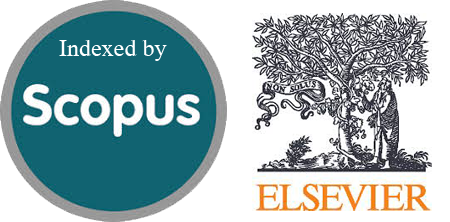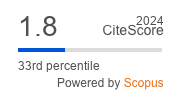Development of MongoDB-based Gait System with Interactive Visualization for Clinical Analysis
Abstract
Gait analysis is a crucial aspect of biomechanics and medical rehabilitation, used to detect movement disorders, assess therapy effectiveness, and understand human walking patterns. In Indonesia, gait research remains limited, with most data sourced from abroad, which may not reflect the characteristics of the local population. This study uses data from Vicon camera recordings that track marker movements on the subject's body and convert them into kinematic data in spatial coordinates, stored in Excel files. To support clinical applications, an efficient system is needed to manage gait data and present analysis results interactively. Therefore, a MongoDB-based gait data management system was developed due to its flexibility in handling unstructured data and scalability. The system was designed to preprocess gait data and display the results through an interactive Streamlit dashboard. The analysis involved calculating gait angle parameters, visualized in a gait cycle angle graph and analyzed statistically using mean and standard error to improve interpretation accuracy. Testing shows that the system can store data in an average of 1.52 seconds, retrieve it in 3.598 seconds, and render visualizations in 0.192 seconds, with high accuracy and only a 0.1-degree error between the input and output. This system effectively addresses the challenge of managing local gait data and supports comprehensive biomechanical analysis, enabling clinicians to make informed decisions regarding rehabilitation needs based on deviations from normal gait angle ranges.
Downloads
References
J. Wagner, M. Szymański, M. Błażkiewicz, and K. Kaczmarczyk, “Methods for Spatiotemporal Analysis of Human Gait Based on Data from Depth Sensors,” Sensors, vol. 23, no. 3, p. 1218, Jan. 2023, doi: 10.3390/s23031218.
J. C. Arellano-González, H. I. Medellín-Castillo, J. J. Cervantes-Sánchez, and A. Vidal-Lesso, “A Practical Review of the Biomechanical Parameters Commonly Used in the Assessment of Human Gait,” Revista Mexicana de Ingeniería Biomédica, 2021. doi: 10.17488/RMIB.42.3.1.
M. Chandrasekaran, J. Francik, and D. Makris, “Gait Data Augmentation using Physics-Based Biomechanical Simulation,” ArXiv, vol. abs/2307.08092, p., 2023, doi: 10.48550/arXiv.2307.08092.
A. I. Mahyuddin, S. Mihradi, T. Dirgantara, M. Moeliono, and T. Prabowo, “Development Of Indonesian Gait Database Using 2d Optical Motion Analyzer System,” ASEAN Engineering Journal, vol. 2, no. 2, pp. 62–72, Mar. 2012, doi: 10.11113/aej.v2.15350.
A. SEUL, A. MIHAI, A. CURTEZA, M. COSTEA, and B. SÂRGHIE, “Biomechanical parameters characterising the foot during normal gait,” Leather and Footwear Journal, vol. 21, no. 2, pp. 87–104, Jun. 2021, doi: 10.24264/lfj.21.2.2.
K. J. Greenlund et al., “PLACES: Local Data for Better Health,” Prev Chronic Dis, vol. 19, p. 210459, Jun. 2022, doi: 10.5888/pcd19.210459.
A. Rind, D. Slijepcevic, M. Zeppelzauer, F. Unglaube, A. Kranzl, and B. Horsak, “Trustworthy Visual Analytics in Clinical Gait Analysis: A Case Study for Patients with Cerebral Palsy,” in 2022 IEEE Workshop on TRust and EXpertise in Visual Analytics (TREX), IEEE, Oct. 2022, pp. 8–15. doi: 10.1109/TREX57753.2022.00006.
R. Fiker, L. H. Kim, L. A. Molina, T. Chomiak, and P. J. Whelan, “Visual Gait Lab: A user-friendly approach to gait analysis,” J Neurosci Methods, vol. 341, p. 108775, Jul. 2020, doi: 10.1016/j.jneumeth.2020.108775.
F. J. Alvarado-Rodríguez et al., “Biomark: A Toolbox for Visualization and Kinematic Gait Analysis,” 2020, pp. 913–920. doi: 10.1007/978-3-030-30648-9_118.
S. Yange, I. Gambo, R. Ikono, O. Onyekwere, and H. Soriyan, “An Implementation Of A Repository For Healthcare Insurance Using MongoDB,” Journal of Computer Science and Its Application, vol. 27, no. 1, Aug. 2020, doi: 10.4314/jcsia.v27i1.3.
C. A. Győrödi, D. V. Dumşe-Burescu, D. R. Zmaranda, and R. Ş. Győrödi, “A Comparative Study of MongoDB and Document-Based MySQL for Big Data Application Data Management,” Big Data and Cognitive Computing, vol. 6, no. 2, p. 49, May 2022, doi: 10.3390/bdcc6020049.
J. C. Gonzalez-Islas, O. A. Dominguez-Ramirez, O. Lopez-Ortega, A. Curiel-Anaya, A. Jimenez-Oropeza, and R. D. Paredes-Bautista, “Virtual Gait Visualization based on Geometric Kinematics,” in 2021 International Conference on Mechatronics, Electronics and Automotive Engineering (ICMEAE), IEEE, Nov. 2021, pp. 3–8. doi: 10.1109/ICMEAE55138.2021.00008.
L. Mobbs, V. Fernando, R. D. Fonseka, P. Natarajan, M. Maharaj, and R. J. Mobbs, “Normative Database of Spatiotemporal Gait Metrics Across Age Groups: An Observational Case–Control Study,” Sensors, vol. 25, no. 2, p. 581, Jan. 2025, doi: 10.3390/s25020581.
S. Sarwar, A. Likens, N. Stergiou, and S. Mastorakis, “A Nonlinear Analysis Software Toolkit for Biomechanical Data,” ArXiv, vol. abs/2311.06723, p., 2023, doi: 10.48550/arXiv.2311.06723.
R. Byali, Ms. Jyothi, and M. C. Shekadar, “"Evaluation of NoSQL Database MongoDB with Respect to JSON Format Data Representation ",” International Journal of Research Publication and Reviews, pp. 867–871, Sep. 2022, doi: 10.55248/gengpi.2022.3.9.24.
E. C. Honert and T. C. Pataky, “Timing of gait events affects whole trajectory analyses: A statistical parametric mapping sensitivity analysis of lower limb biomechanics,” J Biomech, vol. 119, p. 110329, Apr. 2021, doi: 10.1016/j.jbiomech.2021.110329.
Menteri Kesehatan Republik Indonesia, Peraturan Menteri Kesehatan Republik Indonesia Nomor 41 Tahun 2014 Tentang Pedoman Gizi Seimbang. Republik Indonesia, 2014. Accessed: Feb. 17, 2025. [Online]. Available: http://hukor.kemkes.go.id/uploads/produk_hukum/PMK%20No.%2041%20ttg%20Pedoman%20Gizi%20Seimbang.pdf
S. A. Garcia, M. S. White, J. Gallegos, I. Balza, S. Kahan, and R. M. Palmieri-Smith, “Associations Between Body Mass Index, Gait Biomechanics, and In Vivo Cartilage Function After Exercise in Those With Anterior Cruciate Ligament Reconstruction,” Am J Sports Med, vol. 52, no. 13, pp. 3295–3305, Nov. 2024, doi: 10.1177/03635465241281333.
M. Zen, Irwan, Hafni, and M. D. P. Ananda, “Implementasi dan Pengujian Menggunakan Metode BlackBox Testing Pada Sistem Informasi Tracer Study,” Bulletin of Computer Science Research, vol. 4, no. 4, pp. 327–340, Jun. 2024, doi: 10.47065/bulletincsr.v4i4.359.
B. Rupprecht, B. Vogel-Heuser, and E.-M. Neumann, “Measurement Methods for Software Execution Time on Heterogeneous Edge Devices,” in 2023 IEEE 21st International Conference on Industrial Informatics (INDIN), IEEE, Jul. 2023, pp. 1–6. doi: 10.1109/INDIN51400.2023.10218136.
V. Agrawal, “Data Validation : A Complex Challenge in Modern AI Systems,” International Scientific Journal of Engineering and Management, vol. 04, no. 01, pp. 1–9, Jan. 2025, doi: 10.55041/ISJEM01311.
N. Altman and M. Krzywinski, “Depicting variability and uncertainty using intervals and error bars,” Lab Anim, vol. 58, no. 5, pp. 453–457, Oct. 2024, doi: 10.1177/00236772241247105.
S. M. H. Sithi Shameem Fathima, K. A. Jyotsna, T. Srinivasulu, K. Archana, M. Tulasi rama, and S. Ravichand, “Walking pattern analysis using GAIT cycles and silhouettes for clinical applications,” Measurement: Sensors, vol. 30, p. 100893, Dec. 2023, doi: 10.1016/j.measen.2023.100893.
Copyright (c) 2025 Jurnal RESTI (Rekayasa Sistem dan Teknologi Informasi)

This work is licensed under a Creative Commons Attribution 4.0 International License.
Copyright in each article belongs to the author
- The author acknowledges that the RESTI Journal (System Engineering and Information Technology) is the first publisher to publish with a license Creative Commons Attribution 4.0 International License.
- Authors can enter writing separately, arrange the non-exclusive distribution of manuscripts that have been published in this journal into other versions (eg sent to the author's institutional repository, publication in a book, etc.), by acknowledging that the manuscript has been published for the first time in the RESTI (Rekayasa Sistem dan Teknologi Informasi) journal ;








